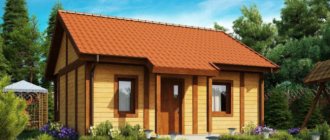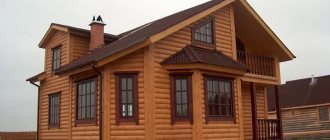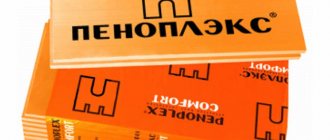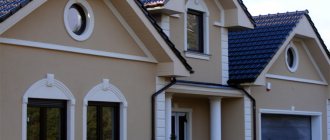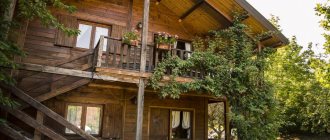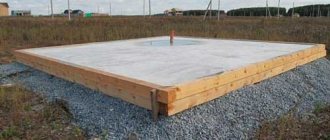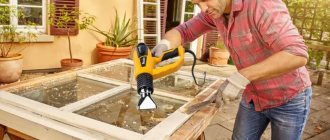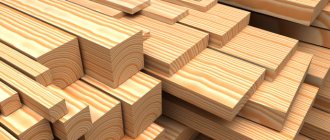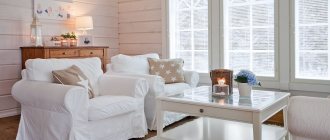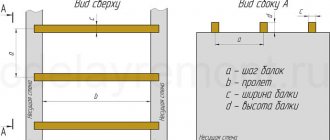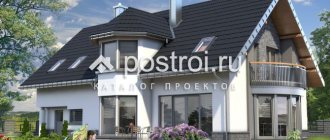Having bought a plot of land, the owners think about its improvement. The main priority remains building a house. One of the most popular types of private construction is the construction of wooden buildings. They are distinguished by their pleasant appearance, reliability and environmental friendliness. But to preserve these qualities, you need to protect your home from moisture and dust. The best way to preserve beauty is painting a timber house.
- Preparation
- Carrying out painting
When is it necessary to paint the outside of a laminated timber house?
- First of all, the main task of paintwork is to increase the attractiveness of the surface being treated. In the case of a wooden wall, you can easily emphasize the natural beauty of the material, since cut wood already looks quite aesthetically pleasing.
- Wood darkens over time, and sooner or later its texture will have to be masked. For this purpose, compositions with greater hiding power are used to hide the pattern on the surface.
- Painting compositions, impregnations and mastics help protect wood from the negative influences of the external environment. The time of preservation of natural beauty depends on the level of protection.
- In addition, preventing wood from coming into contact with microorganisms and moisture has a positive effect on its performance characteristics: a well-painted house retains its load-bearing capacity longer and does not rot.
- Another factor that negatively affects the condition of the timber is UV radiation. UV filters, namely the substances that make up most modern paints, help protect against it.
As you can see, there are many arguments in favor of painting the outside of a laminated timber house. Now you need to decide on the type of painting and the best technology for applying it.
What to choose for painting?
Compositions for internal use
The main purpose of interior paint is to give wooden walls an aesthetic appearance. Maximum protection is required inside the house, for this reason we recommend focusing not on the decorations.
In terms of materials that can be used to process timber walls inside, experts advise using:
- Impregnating compounds - waxes, drying oils, wood oils, etc. All these products do not form films on the surface of the wood, for this reason the appearance of the wall is practically unchanged. At the same time, the texture of natural wood and the contrast of the fibers are emphasized.
- Mastics - maintain the velvety surface, and also highlight the pattern on the cut of the timber. Moreover, mastic allows you to mask small chips and cracks.
- Varnishes (matte and glossy) are the most common compositions used for interior decoration. Typically, a varnish with a tinting component is applied to the base, and then several translucent layers are laid. As a result, the surface receives additional “depth”. Varnish is primarily useful where the timber wall is most exposed to friction, for example, along the stairs.
- Interior paints. Painting wood inside a house can be done with compositions with different covering power, depending on what kind of task they are faced with. If you want to preserve the natural pattern of wood, then glaze acrylic compounds are used. If it is necessary to give the wall a new color, then an alkyd or acrylic-based covering paint is used.
Almost the same paint and varnish materials are used to treat a wide variety of wooden components inside the house. Thus, painting imitation timber or clapboard cladding indoors can be done with the same acrylic varnishes or paints as used for processing timber.
Protective treatment of critical structures
Application of protective compounds
Structural elements of the house that must be treated with special care include:
- Mortgage crown,
- Corner ends of the log walls,
- Attic structures,
- Floor joists on the first floor.
These elements are most susceptible to external negative factors and are most often affected by biopests; it is necessary to choose the right ways to protect them.
The best way to process the embedded crown
The frame is the lowest crown of the log house, the most vulnerable to putrefactive fungus, this is caused by its getting wet from moisture accumulating on the edge of the foundation. Conventional protective agents are ineffective in this case; experienced professionals recommend using “folk” remedies that provide more effective antiseptic protection. Among such means:
- A solution of copper or iron sulfate, the timber is placed in a bath with a 1.5 percent solution of vitriol for 2-3 hours, the composition is deeply absorbed into the wood, the timber is ready for use after drying for 3-4 hours,
- Finnish composition, which is prepared according to the following recipe: a homogeneous paste made from 750-800 g of any flour is poured with 10 liters of warm water, alternately adding 1.5 kg of copper sulfate, 400 g of salt, 1.5 kg of slaked lime and stirring thoroughly. The timber is treated on all sides in two layers, the composition is applied with a brush or roller, complete drying time is 12 hours.
Corner end protection
The corner ends of the log house absorb 10 times more moisture than the walls; the process of intense wetting and drying causes the appearance of deep cracks, which create a favorable environment for the development of putrefactive fungus. To reduce this process, the ends are “riveted” with a rubber or wooden mallet; deliberate destruction of the wood structure prevents the formation of deep cracks. After this operation, the ends are impregnated from the outside with deep-penetrating compounds such as “Aquatex”. When finishing the ends, a protective acrylic coating “TEKNOL JRM” (Finland) or a water-dispersion agent “Remmers SW-910” (Germany) is used; the compositions form a durable protective film resistant to low temperatures.
Treatment of attic structures
Fire statistics show: fires in wooden houses and bathhouses begin in the attic; chimneys and ventilation hoods are located in this space. From the outside, atmospheric moisture does not penetrate into this space; in summer the air temperature rises above 40 degrees, the racks and rafters are always dry, which increases the likelihood of fire. Rafters, roofing sheathing and counter beams are additionally impregnated with fire retardants, including: non-flammable paints and varnishes, fire-resistant pastes and mastics. A popular fire retardant is biopyrene “Pirilax” (Russia), which has antiseptic properties.
Protection of joists under the floor on the first floor of the house
Logs under the floor are classified as hard-to-reach structures, the periodic processing of which is difficult. The joists on the ground floor of the house are protected from atmospheric moisture, while at the same time, excess moisture accumulates in the basement due to soil evaporation. Such conditions are favorable for the development of harmful insects, rodents and fungi. To reduce air humidity in the underground space, natural ventilation is installed.
Floor joists are treated in various ways; one of the effective methods is burning the surface with a blowtorch. Wood capillaries are destroyed by fire, the process of natural moisture absorption is disrupted, and the ash layer is an antiseptic. After such treatment, the logs are impregnated with finishing compounds, including bitumen impregnations and mastics.
Painting the outside of a laminated timber house: varnishes, paints and impregnations
External processing of laminated veneer lumber is primarily aimed at protecting the house from the effects of negative environmental factors, as well as changing its appearance.
Analysis of compounds used for processing:
- Organic or water based impregnations. They are not actually paints as they have little effect on the appearance of the home. Their main function is damage by microorganisms, protection from fire, etc.
- Film-forming compositions (can be either opaque or translucent). They protect the wood from contact with moisture, but do not prevent the evaporation of liquid from the thickness of the wood.
- Coloring antiseptics are compositions that are intended for external treatment of timber houses.
- Exterior paints. In terms of characteristics, they are close to film-forming compositions, but their main function is to change the color of the surface. Although painting the outside of a timber house using paints from leading manufacturers often replaces protective treatment.
Popular paints for the facade of laminated timber houses
Houses made of laminated veneer lumber look very attractive, but every year their appearance deteriorates. This happens under the negative influence of the environment. Decorative painting allows you to solve this problem. Proper painting of walls includes a set of actions that we will discuss below.
The color of the coating is chosen in strict accordance with the design of the house. Contrasting tinting will highlight the natural pattern and emphasize the structure of the wood. Paints will add richness to the walls and cover up the wood. But the final choice always depends on the residents of the house. Whatever color you choose for a house made of laminated veneer lumber, it must meet the main requirements.
- German. Paints of this brand are produced on the basis of water, which means they are highly environmentally friendly. They are conveniently applied to a wooden base; such material retains heat for a long time. Paint and varnish materials are presented in a wide range. The cost is in the average range. A significant drawback is the need to regularly update the coverage (every five years).
- German. The material is oil-based and therefore does not cause harm to human health. Perfectly emphasizes the structure of wood and is easy to apply. Retains its original shade for a long time and does not require regular updating. It is often used for interior and exterior work. Its main drawback is its unreasonably high price.
- Finnish. It’s worth saying right away that the paints of this company are presented in a rich assortment. Among the advantages, it is worth highlighting the low cost, high color fastness and pleasant color; among the disadvantages is the need for constant updating - approximately every 5 years.
- Domestic. Paints are offered in a wide range and at an affordable price. They retain their original color for many years, but require regular touch-up (at least once every five years).
- Domestic paints "Termika". The coatings are highly resistant to temperature changes, ultraviolet rays and moisture, and are perfect for painting the outside of laminated timber houses. The prices are quite reasonable, but the assortment leaves much to be desired.
Exterior painting of laminated timber walls
Proper preparation is the key to effective results.
Glued laminated timber is a material with excellent performance characteristics. It is almost not deformed during shrinkage, and yet it is necessary to process or paint it in another way only if certain rules are strictly observed.
Attention! Experts advise starting work no later than 3 months after the construction of buildings. If you allow the house to stand longer, the timber will gradually begin to deteriorate under the influence of climatic factors, which will negatively affect the adhesion of paint to wood.
To properly prepare the surface for painting, here are the instructions:
- Painting is carried out at a temperature of at least +5 degrees. As for interior work, humidity should be no more than 80%.
- To improve the adhesion of paint to the surface of the timber, all painted surfaces must be plastered and sanded.
Attention! After sanding, you need to “walk” over the walls using an industrial vacuum cleaner. The joints of the beams deserve special attention, since this is where most of the small sawdust, as well as wood dust, accumulates.
- We apply a special sealant to the ends of the beams.
- Primer for sanded surfaces. Typically, the price of primer compositions is low, but they provide high-quality paint adhesion. Therefore, it is better to spend money on a primer and save on buying expensive enamel or acrylic compounds.
- Paint can be applied only after the primer has completely dried.
As for the technology of external and internal processing of timber walls, it is almost no different. The only difference is the number of layers of material that is applied to the base.
If you plan to do the painting yourself, follow these tips:
- Paints must be mixed according to the manufacturer's instructions. The situation is exactly the same with varnishes with tinting components.
- Prepare a clean and large container for mixing.
- Before starting work, test the composition by using it on a small area. This way you will get an idea of the appearance of the wall.
Attention! This must be done, since the color of the wood greatly influences the final result. Therefore, test coloring allows you to make adjustments and, possibly, reduce or increase the amount of pigment.
- To apply paint, use a roller, brush or spray. It is recommended to apply varnishing using a brush.
- First, we apply the first layer of material to the wood flooring. The smaller its thickness, the better.
- After it dries, we continue painting. To process timber walls, you may need from 3 to 5 layers of material. All of them can be applied only after the previous one has dried.
After finishing painting, you need to wait until the walls dry. After 1-2 months, you should carefully inspect the surfaces and, if necessary, seal any cracks and crevices with sealant. Apply paint over the sealant, following the same technology as when painting a house.
Some tips for painting the outside of a laminated timber house
To paint the facade of a wooden house, you need to carry out preparatory measures and adhere to some rules. We will provide some tips below.
- Before painting, the surface must be thoroughly cleaned of dust and dirt with a brush. This work is best done using water. To do this, use a garden sprayer and a medium-hard brush, which are convenient for removing dirt from the surface.
- Get rid of mold with special solutions. There are a lot of them on sale. To find mold, simply inspect the walls for gray-blue stains.
- To get rid of tree resin, you should use a metal spatula. After you remove the resin, only a small hole will remain, which can be sealed with varnish.
- If nails or other metal elements protrude from the surface, they must be treated with compounds that prevent corrosion.
- After all preparatory measures have been completed, the wood is allowed to dry. This process may take approximately 2 weeks. To protect the material, you will need to cover the structure with plastic film, which has holes for ventilation.
How much does it cost to paint a laminated timber house?
Of course, you can paint the house yourself by studying our material and reading the photos, but this will take a lot of time and effort, especially if you have a large cottage. Therefore, most people still resort to the services of professionals.
The cost of painting laminated timber walls depends on the following factors:
- prices of materials used;
- worker qualifications;
- type of work required.
We present you the average cost of coloring services in our country in the form of a table:
| Types of services | Price in rubles | Per m2 |
| Sanding walls and other surfaces of laminated timber | 120-160 | |
| Antiseptic | 80-90 | |
| Painting laminated veneer lumber (roof overhangs, walls, beams, pillars, front board) in one layer | 90-100 | |
| Removing lint from timber walls | 40-50 | |
| Processing the ends of the timber (sealing and grinding). | 360-400 | Per linear m |
| Painting of platbands (including dismantling and installation). | 140-150 | |
| Painting fencing of terraces and balconies | 700-800 |
The desire to embellish and also protect your house, built from laminated veneer lumber, is completely justified. Such a building will not be cheap, which means it will be built to last for many years. Moreover, the decor and coloring of the walls will give your home individuality and express your fantasies and dreams. Agree, this is important!
Conclusion
Interior and exterior painting of a timber house is a must if you want to add durability to the building. Despite the fact that laminated veneer lumber is quite easy to paint, it is worth following some recommendations. In this case, the paint will have to be updated less often, and the appearance of the house will be much better.
The most effective means for treating the outside of your home
For those who are interested in how to treat timber, how to cover imitation timber, how to protect a timber and log house from insects, mold, rot and fire, we have compiled a list of the most popular and effective products that are suitable for external treatment.
"Senezh". The domestic manufacturer produces tinting and preservative antiseptics based on acrylate and water, bleaches and fire-retardant compounds. Under the Senezh brand, more than twenty types of hard-to-rinse products are produced for treating the facade and bottom of a log house, providing protection for wood for more than ten years.
"Belinka". This brand offers a wide range of protective products that protect wood from moisture, insects, UV radiation and fire.
"Pinotex". Polymer-based products are perfect for internal and external processing of timber, including imitation timber. The products are resistant to large temperature changes and protect the simulated timber from moisture, fungus, and microorganisms.
"Neomid". Antiseptics for external use, protecting wood from biological damage for 6-7 years. The manufacturer also produces fire retardant compounds, wax impregnations, bath oil, and special products for processing ends.
"Tikkurila". The Finnish company produces moisture-resistant preparations that create a protective film on the surface. External wooden surfaces treated with these compounds receive good protection from various atmospheric conditions.
"Aquatex". Inexpensive primers and impregnations made in Russia protect the outer walls of the log house from fungus, moisture and ultraviolet radiation. Available in clear and tinted forms, there are fifteen options in different colors on the market.
carries out all types of work on the territory of Moscow and the Moscow region for finishing a wooden house. The processing of the façade of the log house is carried out by our craftsmen strictly according to technology, taking into account the peculiarities of the structure. All materials we use have the necessary certificates.
You can ask questions, send your application and call a specialist to draw up an estimate using the coordinates located in the “Contacts” section.
If you require legal advice , we can advise you. These are our partners with whom we have been working for several years and trust them to resolve all legal issues.
Calculate the cost of painting and insulating your home right now
Select types of work:
Select materials:
Painting a house made of laminated veneer lumber: choosing paint coatings and how to paint correctly?
Wood has many advantages over other building materials, since it is natural. Thanks to this, a house built of wood maintains a special microclimate at any time of the year: it is easy to breathe, cool in the heat, and warm and cozy in winter. Modern wood processing technologies provide a wide selection of building materials that are not inferior in strength and durability to brick and concrete. Glued laminated timber is gaining great popularity among all types of new generation materials. Distinctive features of this material are: super strength, good thermal insulation abilities and high constructability.
Having a smooth surface, laminated veneer lumber does not require additional decorative finishing during construction. But in order to preserve the original properties of wood and protect its appearance from the effects of natural conditions, it must be treated with a special antiseptic coating. It is advisable to paint a house made of timber as soon as possible, without leaving untreated material before winter or for the next season. In this case, it is possible to protect wooden surfaces from moisture, mold and rot. It is advisable to obtain recommendations on choosing a suitable product from a qualified specialist; he will advise which coatings are best to use for external or internal work indoors.
Why are external walls treated with bleach?
Bleaching compounds contain chlorine or hydrogen peroxide, which have a detrimental effect on microflora; these products are used to treat the outside of buildings. The operation has a dual purpose:
- Affects spores of all types of fungus,
- Cleans the surface of the timber and the pores of the wood from contaminants.
Before and after applying bleach
Bleaching of the outside of a log house is carried out for preventive purposes and to update the facade; during the period of operation of the building, this operation is repeated periodically. Experts recommend treating walls in this way every time before applying protective impregnations. The most popular products include: “CEDAR (Bleach)”, “Nortex-Bleach” and “Bioshield-2”; a sprayer can be used to apply these solutions.
Types of paint and varnish coatings
At the moment, there are two types of coatings: impregnating and film-forming antiseptics. Impregnating coatings, in turn, are divided into two subtypes:
- water based;
- on an organic basis.
Water-based antiseptics easily penetrate into the wood and do not have a specific odor - while the wood retains its natural properties. Organic-based impregnation also has good penetrating properties. This product contains various valuable additives that are intended to prevent and combat mold and mildew. Film-forming coatings are divided into:
- transparent compounds (so-called glazing);
- opaque.
The glaze composition is more transparent, which allows you to preserve the original appearance of the wood structure. The final color of the future surface depends on the quality of the wood, its species and the original color. The number of coating layers applied also affects the final color of the surface. When choosing such a composition, you need to keep in mind that over time it is washed out by water under the influence of the environment and will therefore require repeated surface renewal.
Opaque (opaque) compounds are similar to paint. They completely cover the wood and, after drying, a film is formed on the surface of the material, protecting the laminated veneer lumber from fungus, mold and moisture. Also, resistant to atmospheric conditions and ultraviolet rays. At the same time, thanks to a very thin layer of film, the properties of the wood are not lost.
Features of the harmful effects of the environment
It is recommended to paint wood due to the need to protect the surface from many harmful natural factors to which the façade of a house is constantly exposed. The following impacts can be identified:
- Water has a destructive effect on a wooden structure; over time, the material becomes covered with unsightly stains and stains appear. The result will be darkening and deterioration of integrity;
- Ultraviolet radiation also leads to a change in surface color;
- Insects and pests destroy the tree;
- Humidity can lead to biological formations.
You need to move on to coloring faster; usually you can wait no more than 3-4 months.
It is recommended to paint wood due to the need to protect the surface from many harmful natural factors to which the façade of a house is constantly exposed.
Painting process
Before starting work, it is recommended to read the instructions located on the packaging of the products used. There must be enough paint to cover the entire surface, otherwise when repainting the color will differ from the original. The surface prepared for painting must be dry. Painting should be carried out at a temperature not lower than +5̊ C; you cannot paint in the evening - evening dew will spoil the quality of the coating. Various oils, mastics and paints and varnishes are used to treat wooden surfaces indoors. Based on drying oil and linseed oil, they are harmless to human health. Oil gives the surface a beautiful shade, while at the same time preserving the unique grain of the wood. But this is not enough for high-quality processing, because the proposed products cannot cope with dampness and dirt. If an appropriate microclimate is maintained in the room, then the walls inside the house will be less susceptible to fungus or mold. Natural mastics help hide wood imperfections, figuratively “removing” defects. Mastic gives the surface a matte appearance, while protecting it from dampness and various contaminants. The disadvantage of using mastic can be considered the labor intensity when processing wooden surfaces. Another disadvantage is that after its use, the wood stops “breathing”.
Various types of varnishes are widely used to protect wood:
- Acrylic;
- Alkyd;
- Polyurethane.
Painted surfaces, depending on the paint coating used, acquire a glossy, semi-matte or matte appearance. The wood receives good protection from mold and dampness. Under such a coating you can hide possible defects. Also, they are not afraid of wet cleaning - you can simply wash them. The tree retains all its properties. The disadvantage of using varnish is its toxicity during painting. But after drying, paints and varnishes become harmless to others.
More interesting articles on our website https://www.dom-brus.com
Paints used for interior work
Painting of timber inside a house is carried out using painting materials that differ significantly in technical characteristics from façade paints. To cover internal wooden walls use:
- Wax. It protects wood well from moisture, increases its service life, gives the surface shine and a pleasant appearance. But the cost of this material is quite high.
- Mastic. The material is used to level the surface. The wood acquires a velvety structure, thanks to which the natural grain of the wood is visually enhanced.
- Varnish. The material makes the surface smooth, but does not allow the walls to breathe. It is better to use it in rooms with low humidity.
- Acrylic, alcohol and oil paints. The saturation of color pigments allows you to eliminate defects, and the variety of color palettes will be a good option for creating an interior of any type.
Each composition solves its own problems, so the choice of material for surface finishing must be carefully considered.
Why paint laminated timber?
Despite the use of an adhesive base, the material is breathable and “living”. This means that the surface after construction of a house made of timber is afraid of direct sunlight, moisture and temperature changes. Painting the surface with various protective agents will save the owner from further forced repairs.
For protection, special primers are used - antiseptics, which will prevent the appearance of fungi and mold. And in the second stage, a layer of protection from direct sunlight is applied.
It is also important how the walls will look, which is why both glazing and matte covering compositions are used.
Features of timber production
With the advent of this material on the market, it has become much easier for St. Petersburg builders working with wood to obtain high-quality buildings.
The parts used in the production of houses from profiled timber are manufactured using a special technology: First, high-quality timber from pine species is carefully selected and sorted. Then the timber is sawed into a carriage (half-timber). Obtaining the necessary moisture content without disturbing the geometry of the tree is possible subject to a complex drying process , therefore, in drying chambers this procedure takes place in a soft mode, lasting about 20 days. The lath is cut into timber. The product is given the required shape. Corner joints are cut, holes are drilled for dowels and electrical wiring, grooves and openings are selected. Antiseptic treatment is carried out. As you can see, the production of houses from profiled timber is a complex process in which every detail matters. The Roshchinsky House-Building Plant company invites you to visit our workshop for the production of building materials from wood. Our specialists will show you how the production process works and tell you about quality standards.
All wooden buildings require regular maintenance - this is a feature of the natural material from which they are built.
Houses made of timber are no exception. In order for a wooden building to last for many years and retain its original appearance for a long time, it is advisable to treat the internal and external surfaces at least once every 3-4 years. There are a huge variety of products for protecting and decorating wooden walls - impregnations, antiseptics, oils, fire retardants. For those who have just started building their own wooden house or garden house, such a variety of means can easily confuse them at first - you won’t be able to figure out what means to use and for what. In this article, experts from the construction company “Besedki-Domiki” will go into detail they talk about how and with what to properly treat a house so that it will delight more than one generation of owners with its beauty and comfort.
Products for covering a house made of laminated timber
House made of laminated veneer lumber, painted with glazing compounds
There is no point in delaying painting a house made of laminated veneer lumber. You need to paint it right away, and it’s better to soak it with antiseptics for the first time before assembling. Various compositions of domestic and imported production are sold for coating.
But not all of them have the appropriate quality; experts recommend using Osmo, Sikkens (AkzoNobel), Tikkurilla products. If painting is done correctly, it will need to be repainted no earlier than after 4-5 years.
The qualitative characteristics of some of them can be seen in the table:
| Manufacturers | pros | Minuses | price, rub. |
| Sikkens (AkzoNobel) (German manufacturer) | They produce a water-based coating, do not fade in direct sunlight, excellent adhesion, many color options, low cost. | You need to constantly monitor it, because after 5-6 years it begins to peel off. | From 120 l. |
| Osmo (German manufacturer) | There are both water-based and oil-based coatings that do not fade over time, protect the wood from destruction, and are easy to clean. | The price is high | From 320 l. |
| Tikkurila (Finnish production) | An assortment of more than 35 colors, there are formulations based on natural oils and water, does not fade in the sun, and a reasonable price. | It will have to be repainted after 3-4 years. | From 150 l. |
| Marshal (Russia, Moscow) | Low cost, does not fade under the sun, a wide range of paint and varnish coatings. | Not durable, repainting will have to be done every 2-3 years, slight coloring. | From 100 l. |
| Finncolor (Russia, subsidiary of Tikkurila) | The assortment of flowers is more than 35, many different varieties, including water and natural oil, low cost. | You will have to update it every 3-4 years. | From 120 l. |
When choosing a coating composition after completing the construction of a house made of laminated veneer lumber, you need to focus on a number of factors:
- External or internal coating. (There are universal products that are used both outdoors and in the house, but it is better to use separate ones, since the main function of the internal one is decorative, and the external one is protective).
- The appearance of the walls (whether the owner wants to preserve the natural pattern and texture or not).
- What effect do you want to get (protection, or to emphasize beauty, or both at once).
For laminated veneer lumber, two types of coatings are used: film-forming and impregnating.
Impregnating compositions
Impregnation of a house made of laminated veneer lumber
Impregnating antiseptics can be divided according to their composition:
- Water based
- Organic based.
Impregnations - water-based antiseptics do not have a strong odor and easily penetrate the wood. The timber after such coating will not lose its quality characteristics. Water-based impregnations are used mainly indoors.
Organic-based impregnations contain various impurities that help prevent the development of mold and mildew. But they may have a specific smell, so these are mainly for external work.
Coating film compositions
These can be divided into transparent and matte. Transparent ones include glazes, which do not hide the wood, but only emphasize its texture and pattern. When coating, the shade may change slightly, but this depends on the number of layers applied, the species and the natural color.
Matte ones will hide the appearance of the wood and give the house the chosen color. These are rarely used for laminated veneer lumber, since the material itself has a noble and beautiful surface.
Do-it-yourself façade coating technology (photo)
You can paint the house with a brush or using a spray gun, however, the latter method requires dilution to a more liquid consistency, which is sometimes undesirable.
To work you will need:
- Brushes – paint brush for primer, flute.
- Spray gun for mechanized painting.
- Sandpaper, Sanding machine.
- Available means are empty containers and a ladder.
- A set of workwear.
- Protective equipment – gloves and goggles.
Before painting the surface of the facade, it must be prepared; processing is carried out in several stages:
- Cleaning from dust, dirt, paint, oil stains and solvents.
- Grinding.
- Cleaning with a brush or blowing a vacuum cleaner.
- Preliminary primer with fire-retardant, fungicidal and antiseptic effects.
- Primer to increase adhesion.
Each layer of primer must dry before applying the next one. The drying time is indicated by the manufacturer of the composition. The quality of painting and the durability of the coating depend on the thoroughness of pre-treatment. Then the paint and varnish composition is applied in 2-3 layers according to the manufacturer’s recommendations.
ATTENTION: When using a brush, painting movements should be in a vertical direction - up and down, horizontal movements give an uneven stroke.
Subtleties of painting a house
All painting takes place in several main stages:
- Sanding the surface of the walls. Even after building a house from profiled timber, the sanded timber must be passed through in one layer with the finest nozzle. During construction, the walls will still get dirty and, without sanding, the paint will lie unevenly.
- Applying a primer is an antiseptic. It will prevent the appearance of mold and fungi and increase the adhesion of paint to the timber.
- Painting. Varnish or paint is applied in several layers. Moreover, each subsequent one is applied only after the previous one has dried.
When painting, it is important to carefully treat the ends of the timber. If the ends are not sealed, moisture will easily penetrate inside through the capillaries. To do this, use all possible sealants, the cheapest of which is liquid glass. To enhance the effect, you can tap the ends with a rubber hammer before painting. But you need to be careful, as the slats may come apart.
Before painting, it is important to study the instructions for use and correctly calculate the paint consumption. It is better to purchase a little more, since even from the same manufacturer there may be a slight difference in shade in different batches.
It is not recommended to paint outdoors in damp weather and at temperatures less than +5 degrees. The surface of the timber must be cleaned of dust and sanded. It is not recommended to paint outside in the evening, as dew will ruin the surface.
To treat interior walls, oils and mastics based on natural oil or water are mainly used. But they are not sufficient to protect against moisture and dirt, but there are enough of them inside the house. The walls are coated with glossy or matte varnish on top.
If you don’t have the opportunity or skill to paint the walls yourself, then it’s better to turn to specialists.
How to correctly calculate the cost of funds
Industrially made impregnations for log houses are usually sold in the form of a powder or concentrate, which are then diluted with water. The diluted solution is 5-10 times the original volume of the product. For example, from a 5-liter canister you can get about 50 liters of ready-made antiseptic.
The calculation of the product required for treatment is based on a standard consumption of 0.3 liters per 1 m2 for one treatment layer. If you perform a simple calculation, you can calculate that 1 liter of concentrate will be used for a single treatment of an area of 60 m2. Thus, one five-liter canister will be enough for three-layer treatment of a house with an area of 100 m2.
How much does it cost to paint walls
The cost of painting laminated timber depends on:
- Dimensions of the area to be painted.
- Whether preliminary preparation is necessary or not.
- Work team qualifications.
The average cost for basic work can be seen in the table:
| Works | Price, rubles | |
| Sanding walls before coating | 130-200 | per m2 |
| Antiseptic coating | 80-90 | |
| Painting walls in 1 layer | 90-150 | |
| Removing lint from the surface | 40-60 | |
| Grinding and sealing ends | 400-550 | Per linear m |
| Painting | 170-230 | |
| Painting extensions such as verandas or balconies | 500-750 | |
Building a house from laminated veneer lumber is not a cheap pleasure. This means that he must have adequate protection. You need to choose high-quality and expensive coverage.
Cost of paintwork
Is it worth inviting specialists, or is it better to save money by doing the work yourself? In different regions of the country, prices for this service do not differ much. The cost depends on the height of the building, volume, number of layers, complexity and amount of preliminary preparation of the walls.
For example, painting 1 m² of the first floor area will cost 500 rubles, to this you will have to add the cost of 1 m² of sanding 300 rubles, finishing the ends 700 rubles, coating with protective agents 300 rubles. Total: 1800 rubles per 1 m² of wall. There is something to think about, especially if the house is large.
It’s worth calculating how much it will cost to cladding a house; maybe such protection will be cheaper and more reliable?
It's up to you to decide, our job is to give some useful advice in conclusion.
How to paint a wooden facade yourself
If there is a need to paint the facade of an already used house, it is quite possible to do this work yourself. To do this, you need to take care of having free time, you will need a lot of it. Purchase consumables in advance: primer and paint in the required volume, coloring pigment (color) and solvent as needed. The approximate consumption rates of the compositions and the service life of the coating are in the table below.
Table 2. Composition consumption rates and coating service life
| Type of paintwork | Consumption (g/m²) | Service life (years) |
| Silicone | 150 — 200 | 20 or more |
| Alkyd | 100 — 120 | 20 |
| Acrylic | 130 — 200 | 15-20 |
| Oily | 100 | 2-3 |
| Water-dispersed | 110 — 130 | 20 or more |
Scaffolding is very convenient for working at heights
In order to put the facade in order, in addition to materials, you will need the following tools:
- stepladder or scaffolding,
- different brush widths,
- rags
- Angle grinder (grinder) with discs for grinding,
- putty knife,
- construction mixer with an attachment for mixing paint.
Depending on the type of paint used, you will need various personal protective equipment: gloves, a respirator, goggles.
Video - An example of incorrect painting of a wooden facade
How often is treatment required?
The first application of protective and decorative agents is carried out immediately after completion of construction - it is best to do this after the construction of the roof. This primary treatment will become the basis for the longevity of the structure and the preservation of its aesthetic appearance.
It is advisable to carry out repeated and subsequent treatment of external surfaces annually, but at least once every 3-4 years.
For the first time, internal processing is carried out simultaneously with external processing. Repeated is done with the same frequency as the external one. Its main task is fire and antiseptic protection.
Comparison of painting with other types of finishes
For analysis, we will take the most popular materials and compare them according to the most noticeable parameters during operation. From the table you will see that paints for wooden facades are not a panacea for all occasions, but in many respects they are better and more practical than, for example, siding or ventilated facades made of porcelain stoneware.
| Dye | Siding | Block house | Brick | Porcelain tiles | |||||||
| Decorative properties | Perfectly preserves the texture and characteristics of the wood surface | Completely hides the base | High, imitates a rounded log | Completely covers the tree | Very decorative | ||||||
| Easy to install and apply | Very easy to apply, just need a brush or roller | Difficult to install, requires special tools | Difficult installation | Difficult installation, requires a concrete foundation | Difficult installation | ||||||
| Price | Cheapest finishing option | More expensive than any type of paint | More expensive than siding | One of the most expensive | As good as brick | ||||||
| Durability | 6-10 years | 20 years | 10 or more years | 50 years | 50+ years | ||||||
| Ability to hide design flaws | Virtually no hiding | Hides completely | Hides | Hides | Hides | ||||||
| Weather resistance | High, but depends on the choice of paint | High | High | The tallest | As good as brick | ||||||
| Resistance to mechanical stress | Resistant only to accidental scratches and impacts. | Does not protect, can be destroyed even with a slight blow | Average | High | The most durable of finishes | ||||||
From the comparison it is clear that the most budget option is painting the walls and other wooden elements of the facade. In terms of mechanical and fire-fighting properties, paint is inferior, for example, to porcelain stoneware or brick, but with the money saved when purchasing material and paying professional builders, you can buy the most modern fire retardants, which make wood completely non-flammable for several decades.
Based on the results of the comparative analysis, you can make a choice in favor of paint. Now you need to make another equally important decision - what paint to paint the outside of a wooden house. Manufacturers produce dozens of types of paints and varnishes intended for external woodwork, but only a few of them may be suitable for a wooden house.
It depends on the:
- house material (timber, logs, blockhouse, lining, chipboard, etc.);
- climate zone;
- type of previous finish;
- budget.
As for paint manufacturers, it is best to focus on well-known brands - Tikkurila, Dufa, Finncolor, Beckers, any of the brands that are part of the Akzo Nobel concern. But you should buy them in large retail chains or well-known online stores. Unfortunately, there are now a lot of fakes and outright hack work on the market, so if you decide to save a few rubles, you risk ruining your home and incurring significant financial losses - redoing poor-quality painting is a very labor-intensive and expensive process.
You can find out what paint is best to paint the outside of a wooden house on the official websites of the manufacturers; if the paint offered to you is not there, then you should not buy it, even at the most attractive price.
Tasks for painting walls from the inside:
- The coating protects the wall from dirt and abrasions. The sanded surface is easy to stain - the dirt eats into the wood, and sometimes you have to remove a layer of wood to remove it. It is much easier to wash off dirt from a painted wall.
- Paint is needed to protect against high humidity and direct ingress of water. If it is decided to leave exposed wood in the “wet zone,” then the walls are painted with a waterproof compound or covered with a moisture-resistant impregnation. This technology is used in bathrooms, swimming pools, and kitchen work areas.
- The right shade helps solve design problems. The color of the walls is chosen taking into account the purpose of the rooms: calm shades for bedrooms, neutral shades for common areas, bright shades for the kitchen and living room. It is important not to overdo it with saturation, otherwise the walls can visually reduce the volume of the room.
Bedroom in a house according to the SV-4 project
Why are the ends sealed?
A special sealant is applied to the ends of the beam, which completely blocks the ingress of water through the end cut, without interfering with natural moisture and air exchange. Without sealant, moisture quickly absorbs and evaporates through the cross section, the wood swells, cracks, and collapses. It is easier for pests to penetrate the tree through the end. The most correct option is to tightly seal the ends.
What has a detrimental effect on wood?
Among the most important enemies of wood, it is worth highlighting moisture in all variants. Rain, snow, steam destroy the structure of the fibers, and mold begins to appear. Such exposure significantly reduces the service life of even the highest quality wood. This is why wood impregnation should be used.
Ultraviolet exposure does not affect the structure of wood as much. The timber does not rot under the sun's rays, but its appearance is lost. The top layers of the material begin to darken, acquiring a gray, dull color that no one likes.
An equally important factor is the moisture content of the wood. For the construction of houses, it is necessary to use dried and prepared timber.
But in practice, houses are built from under-dried material, which, after drying, begins to deform and burst. Taking into account all the factors, we can say that processing a wooden house is not only recommended, but is mandatory.
Processing results
- Long-lasting barrier against pests, insects, fungus. The sealant protects the end, the antiseptic impregnates the outer part, and the paint prevents the protection from being washed away.
- Ultraviolet light does not cause wood to darken. The house retains its “fresh” color. If the color is chosen correctly, then there is no resin release or burnout on the surface.
- Moisture protection. The film covers the entire wall, even after a serious rainfall the walls do not get wet.
- The house corresponds to the design project. The cottage is beautiful inside and out.
Recipes of our grandfathers
We didn’t come up with ways to protect wood.
Our ancestors knew how to preserve what was built to last, without resorting to expensive means, but using what was at hand.
Eg:
- Waste from various oils (linseed, hemp, machine) is perfect for treating walls. The only thing you should exclude is sunflower; on the contrary, it will attract insects.
- Firing with a blowtorch. The procedure helps to clog the wood capillaries and stop the movement of moisture through them. As a plus, there is also a pleasant shade of the walls, with the effect of noble types of wood.
- Tar, bitumen or tar. The material is highly flammable, so it can only be applied to those parts that are dug into the ground. For example, pillar posts.
- Copper sulfate will repel insects and prevent mold from developing.
- Drying oil heated to boiling. Absorbs tightly, forming a safe film for many years.
- The gaps between the crowns can be rubbed with a mixture of manure and clay. The method is not the most aesthetic, but it is cheap and practical.
Technology
The whole process takes place in 4 stages. At the same time, scrupulousness and attention are required to complete the work. It is important to do everything carefully, without leaving untreated areas.
Stage 1. Removing the old coating. This procedure is performed if there is an old paint coating. It needs to be removed. To do this, you can use spatulas, a wire brush, sandpaper or a grinder with an attachment. There will be quite a lot of dust, so you should work with glasses and a respirator.
All work is carried out in dry, not hot weather. The entire area of the facade will have to be protected, including the joints of logs or boards. In order for the work to be completed efficiently and without delay, remove the drainage elements, shutters and trim from the facade in advance. In addition to old paint, dust and street dirt should be removed from the facade.
Important! You should not leave old paint on, even if the layer sits firmly on the surface. Its service life will expire and it will peel off along with the new coating.
Before painting the facade, remove the old coating
Stage 2. After the facade is cleared of paint, the wood is sanded and puttied. If there are areas of darkening, or pockets of fungal infection are visible, the top layer of material should be removed to a clean texture. The rest of the surface is leveled. Existing defects on the surface are eliminated by puttying. Before moving on to the next steps, the putty must dry. The putty material must be compatible in composition with impregnation and paint.
The top layer of wood is cleaned and sanded
Stage 3. Deep penetration impregnation is applied to the cleaned wooden surface, the composition of which is selected depending on the characteristics that require strengthening. Typically, impregnation is applied with a wide brush along the grain to preserve and emphasize the natural texture of the wood.
Do not neglect priming; impregnation will not only improve the quality of the wood, but will increase the adhesion of paint to the surface, while reducing the amount of material consumed. Even though wood primers are quite expensive, their use is worthwhile. Before applying the paint, the impregnation must dry; the period for complete drying is indicated by the manufacturer on the packaging.
For longer service life, the wood should be impregnated with certain compounds.
Step 4. Before starting work, check the long-term weather forecast. Rain is not suitable for painting, nor is heat. In addition, work should be carried out during the daytime, when the dew has either already evaporated or has not yet settled, that is, from 10 to 18 hours. The paint is applied in several layers along the fibers. Each subsequent layer should be applied only after the previous one has dried.
To paint a wooden facade, a wide brush is usually used.
Video - Technology of painting a wooden facade
Some nuances of coloring
It would seem that the process is quite simple and transparent. But here, as everywhere else, there are nuances:
- If the facade has external metal fastening elements, then before priming and painting they should be filled with an oil or acrylic compound to match the color of the wood. This work will be especially relevant if the finishing coating is planned to be made transparent.
- If you approach the issue carefully, you can use several impregnating compounds; water-repellent impregnation is applied last.
- For better surface quality, after the impregnation has dried, the wood should be sanded to remove small roughness and lint.
You can improve the quality of a wooden surface by sanding the wood after applying the primer.
